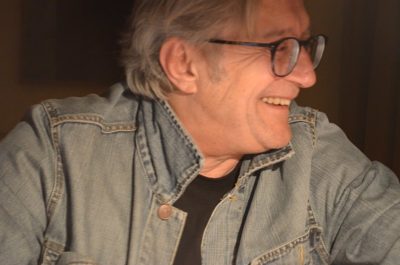dedicated to Franck André Jamme (21 nov 1947 – 1 oct 2020)
16. Marvelously anonymous. Like an antidote. Or a balm.
26. … The lighter, the purer…
37. Abstraction. To abbreviate.
To see it all, finally together.
from Silhouettes and Keys
a writing on Tantra Drawings
by Franck André Jamme
I was saddened when I heard about the passing of Franck André Jamme. A poet who opened a door into Tantric Art for so many of us. I immediately thought back to an exhibition he curated at the Drawing Center in 2004. I remember what an intense impact this show had on me, and I had written about it at the time. I looked for what I had written and found it in the journal entry of November 6 (Saturday), 2004. There were two shows going on in the Drawing Center at the same time. The first was “Richard Tuttle: It’s a Room for 3 People,” in the main space at 35 Wooster Street. The other was “Field of Color: Tantric Drawings from India,” the one Franck André Jamme curated at the Drawing Room, an annex space across the street at 40 Wooster Street. A fascinating combination of two exhibitions, indeed.

I wrote my impressions in Japanese, my mother tongue, although I was already doing critical writing in English, my adopted language. I found it very curious to read my writing again and I was surprised how short my piece was. It was a condensed thought, revealed, rather than a critical one, unlike my usual approach of dissecting and analyzing work. As if to reject such a garrulous effort. After reading it a few times, I decided to translate it into English in praise for FAJ’s devotional passion for Tantric Art.
I experienced what it means to lose words on a physical level. The cosmos breathes on the surface of meek, feeble and simple material: paper. The metaphysical logic creates its own existence, marking form and color. The pure image appears at the point where the ego of the creator disperses and dissolves. Exchanging each other’s roles, the evidence of personal creation and a meta-personal space express the utmost consciousness of human existence through visual sensation.
Tan (= Stretch) + Tra (beyond boundaries). These abstract symbolic images are used as an object for meditation in the practice of meditation in the Tantra school of Hinduism. They engage anyone who faces them in depth. A vibration, corresponding to “the one who sees,” emanates the sense of cosmic existence. Unlike artworks or objects created for aesthetic purposes, these colored images reject being called art “work.” Consequently, it also makes the idea of a creator useless.
The emblems breathe in anonymity and are untitled. Removed from the existence and the intention of a creator, in an impeccable silence, they break down the wall of our egos and demand us to appreciate them through their aesthetic sensitivity. These symbols, created with the pure and humble materials such as tempera, watercolor and gouache, prove Abstraction and its essence. The colors expressing the cosmic metaphysics reminded me of those of Ellsworth Kelly. I thought of “色Color” in “色即是空空即是色Color is Void; Void is Color.” Also, I thought of Ad Reinhardt who kept painting “元Gen” as the root color of the universe. And I reflected on the shared quality of anonymity in my own work. I also thought of the sensation of “a Cosmic View” as the most natural state of the flow of THE creative force. The familiar questions over “what is the essential significance of the act of creation?” re-surfaced again in my consciousness.
It is a religious act to meditate on “how and where” abstract images spring from to be concretized in colors. Paul Gauguin’s questions: “Where do we come from? Who are we? Where are we going?” overlap their mystery. In a spiritual practice to free oneself from being on the human level to return to the cosmic truth, metaphysics and physics are essentially one. Standing in front of these images, which exist in a place that refuses words, I shed metaphysical tears.
It is inappropriate to call the people who create these images artists – of a 400-year-old tradition, which seemed so refreshing. I visualized the way nothing turns into something, brush mark by brush mark with Tantrikas. Facing the concretized colors and forms, I thought of the hearts of the people who meditate on these images and their psychic call and response – opening the door to the universal cosmic existential truth. Carried away by the visual vibrations of “painted silence” of Tantric Art, I humbly received the notion of the fact that I myself was breathing being in the infinite mystery.
–Yuko Otomo
Essays
Fantastic piece in which Otomo lays out how an artist can move beyond egocentric painting to an art that has an anonymous aspect in that it touches vibrations and wavelengths that underlie creation rather than more personal aspects of existence
Unbelievable. Thank you very much for your work. I admire your talent.